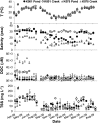Temporal and Environmental Factors Driving Vibrio Vulnificus and V. Parahaemolyticus Populations and Their Associations With Harmful Algal Blooms in South Carolina Detention Ponds and Receiving Tidal Creeks
- PMID: 32158995
- PMCID: PMC7007149
- DOI: 10.1002/2017GH000094
Temporal and Environmental Factors Driving Vibrio Vulnificus and V. Parahaemolyticus Populations and Their Associations With Harmful Algal Blooms in South Carolina Detention Ponds and Receiving Tidal Creeks
Abstract
Incidences of harmful algal blooms (HABs) and Vibrio infections have increased over recent decades. Numerous studies have tried to identify environmental factors driving HABs and pathogenic Vibrio populations separately. Few have considered the two simultaneously, though emerging evidence suggests that algal blooms enhance Vibrio growth and survival. This study examined various physical, nutrient, and temporal factors associated with incidences of HABs, V. vulnificus, and V. parahaemolyticus in South Carolina coastal stormwater detention ponds, managed systems where HABs often proliferate, and their receiving tidal creek waters. Five blooms occurred during the study (2008-2009): two during relatively warmer months (an August 2008 cyanobacteria bloom and a November 2008 dinoflagellate bloom) followed by increases in both Vibrio species and V. parahaemolyticus, respectively, and three during cooler months (December 2008 through February 2009) caused by dinoflagellates and euglenophytes that were not associated with marked changes in Vibrio abundances. Vibrio concentrations were positively and significantly associated with temperature and dissolved organic matter, dinoflagellate blooms, negatively and significantly associated with suspended solids, but not significantly correlated with chlorophyll or nitrogen. While more research involving longer time series is needed to increase robustness, findings herein suggest that certain HAB species may augment Vibrio occurrences during warmer months.
Keywords: South Carolina; Vibrio; harmful algal blooms; phytoplankton; stormwater ponds.
©2017. The Authors.
Conflict of interest statement
The authors declare no conflicts of interest relevant to this study.
Figures



Similar articles
-
Investigating the Relationship between Nitrate, Total Dissolved Nitrogen, and Phosphate with Abundance of Pathogenic Vibrios and Harmful Algal Blooms in Rehoboth Bay, Delaware.Appl Environ Microbiol. 2022 Jul 26;88(14):e0035622. doi: 10.1128/aem.00356-22. Epub 2022 Jul 6. Appl Environ Microbiol. 2022. PMID: 35862751 Free PMC article.
-
Marine harmful algal blooms (HABs) in the United States: History, current status and future trends.Harmful Algae. 2021 Feb;102:101975. doi: 10.1016/j.hal.2021.101975. Epub 2021 Mar 3. Harmful Algae. 2021. PMID: 33875183 Free PMC article. Review.
-
Environmental influences on the seasonal distribution of Vibrio parahaemolyticus in the Pacific Northwest of the USA.FEMS Microbiol Ecol. 2015 Dec;91(12):fiv121. doi: 10.1093/femsec/fiv121. Epub 2015 Oct 9. FEMS Microbiol Ecol. 2015. PMID: 26454066
-
Harmful algal blooms and their effects in coastal seas of Northern Europe.Harmful Algae. 2021 Feb;102:101989. doi: 10.1016/j.hal.2021.101989. Epub 2021 Mar 6. Harmful Algae. 2021. PMID: 33875185
-
Algal blooms historical outbreaks in the northern coastal waters of the Persian Gulf and Oman Sea (1980-2015).Environ Monit Assess. 2021 Sep 14;193(10):648. doi: 10.1007/s10661-021-09413-3. Environ Monit Assess. 2021. PMID: 34523030 Review.
Cited by
-
Climate change and Vibrio vulnificus dynamics: A blueprint for infectious diseases.PLoS Pathog. 2024 Dec 16;20(12):e1012767. doi: 10.1371/journal.ppat.1012767. eCollection 2024 Dec. PLoS Pathog. 2024. PMID: 39680617 Free PMC article. Review.
-
Comparative Study on Temperature Response of Hydropower Development in the Dry-Hot Valley.Geohealth. 2021 Jul 1;5(7):e2021GH000438. doi: 10.1029/2021GH000438. eCollection 2021 Jul. Geohealth. 2021. PMID: 34296051 Free PMC article.
-
Vibrio Species and Cyanobacteria: Understanding Their Association in Local Shrimp Farm Using Canonical Correspondence Analysis (CCA).Microb Ecol. 2024 Mar 15;87(1):51. doi: 10.1007/s00248-024-02356-5. Microb Ecol. 2024. PMID: 38488929 Free PMC article.
-
The organosulfur compound dimethylsulfoniopropionate (DMSP) is utilized as an osmoprotectant by Vibrio species.Appl Environ Microbiol. 2021 Mar 1;87(5):e02235-20. doi: 10.1128/AEM.02235-20. Epub 2020 Dec 18. Appl Environ Microbiol. 2021. PMID: 33355097 Free PMC article.
-
On the Efficacy of H2O2 or S2O82- at Promoting the Inactivation of a Consortium of Cyanobacteria and Bacteria in Algae-Laden Water.Microorganisms. 2022 Mar 29;10(4):735. doi: 10.3390/microorganisms10040735. Microorganisms. 2022. PMID: 35456785 Free PMC article.
References
-
- Allen, J. , & Lu, K. (2003). Modeling and prediction of future urban growth in the Charleston region of South Carolina: A GIS‐based integrated approach. Conservation Ecology, 8, 2.
-
- Arar, A. , & Collins, A. B. (1997). Method 445.0. In vitro determination of chlorophyll a and phaeophytin a in marine and freshwater phytoplankton by fluorescence (Version 1.1. EPA/600/R‐92/121). Washington, DC: U.S. Environmental Protection Agency.
-
- Baker‐Austin, C. , Trinanes, J. A. , Taylor, N. G. H. , Hartnell, R. , Siitonen, A. , & Martinez‐Urtaza, J. (2013). Emerging Vibrio risk at high latitudes in response to ocean warming. Nature Climate Change, 3(1), 73–77. 10.1038/nclimate1628 - DOI
-
- Belsley, D. A. , Kuh, E. , & Welsch, R. E. (1980). Regression diagnostics: Identifying influential data and sources of collinearity. Hoboken, NJ: John Wiley; 10.1002/0471725153 - DOI
LinkOut - more resources
Full Text Sources
